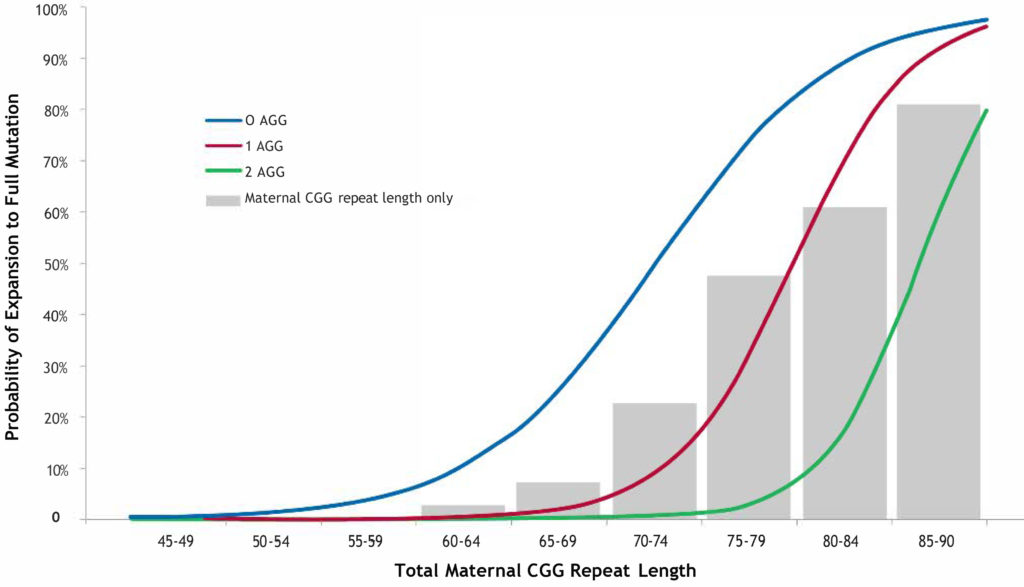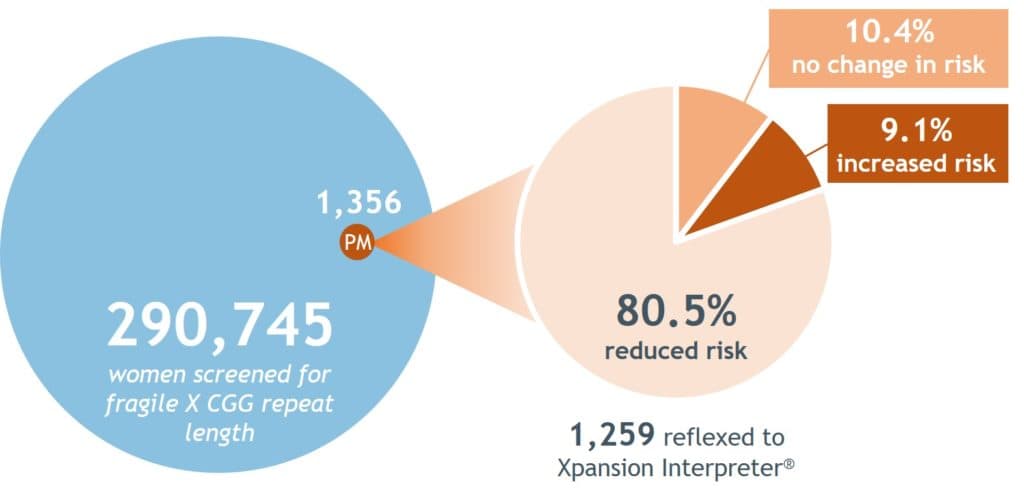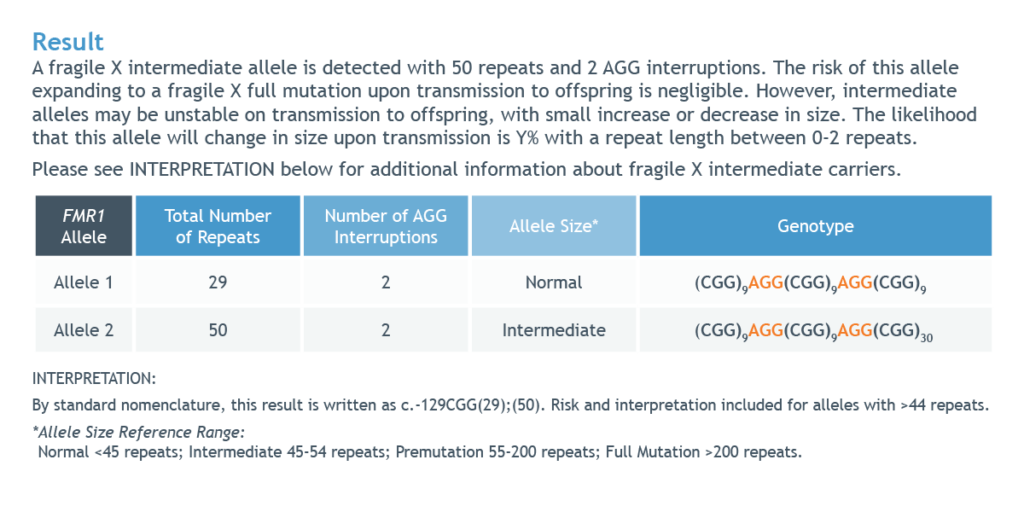AGG Interruption Testing Service
Overview
Testing for AGG interruptions within the FMR1 CGG repetitive sequence may help refine the risk of transmitting fragile X syndrome to the next generation for certain premutation carriers. These AGG insertions “interrupt” the unstable CGG sequences and, as such, determining the number of these interruptions and their location may better inform on the risk of transmission.
Figure 1. Diagram of FMR1 gene and AGG locations.
Asuragen’s scientists collaborated with fragile X experts at the New York State Institute for Basic Research in Developmental Disabilities, Rush University Medical Center, Emory University School of Medicine, and the UC Davis M.I.N.D. Institute to conduct a large study to examine CGG repeats and AGG interruptions in 1,040 parent-to-child transmissions for alleles with 45-90 total repeats (Nolin, et al. 2015 and Nolin, et al. 2013). The studies showed a clear modification of the probability of expansion, of variable sizes and degrees, when number and location of AGG interruptions and number of CGG repeats were considered.
The likelihood for expansion to a fragile X full mutation is based on the total number of CGG repeats and the number of AGG interruptions. In Figure 2 below, the grey bars represent the risk of expansion to a full mutation in the absence of knowledge of number of AGG interruptions. The lines represent the modified risk when AGG information is incorporated. As an example, an FMR1 allele with 75-79 CGG repeats has a 10-fold greater risk of expansion with 0 AGG interruptions (74%) compared to 2 AGG interruptions (7%).
Source: Nolin, et al. 2015 and Nolin, et al. 2013
Figure 2. Impact of AGG interruptions on risk of expansion to Full Mutation
A recent study by Westemeyer, et al. (2020) analyzed the CGG repeats and AGG interruptions from 1,259 premutation women identified from carrier screening in the US. They found that the addition of AGG information adjusted the risk of passing on a full mutation fragile X gene to their child in 90% of women (Figure 3). This result emphasizes the importance of including AGG sequencing analysis as part of fragile X screening to provide the most comprehensive information about a women’s risk.
Figure 3. Reclassification of fragile X risk transmission based on AGG interruption status
Testing Service
Asuragen’s Xpansion Interpreter® testing service employs three different PCR reactions for each DNA sample. Capillary electrophoresis (CE) of the products of one PCR reaction, called repeat-primed PCR, examines this distribution to allow accurate determination of total repeat size (Figure 4A). Characteristic signal “dips” occur at the site of AGG interruptions, as seen by the red arrows in Figure 4B and 4C. Additional information is needed to determine the exact locations of the AGGs in females because the presence of two alleles creates interpretation challenges. Two additional PCR reactions allow resolution of the AGG position and number in females. Through specialized training to interpret the results from all three PCR reactions, the Asuragen CLIA laboratory staff that run Xpansion Interpreter® are able to definitively determine the location of the AGG interruptions in both males and females.
Figure 4. Diagram of FMR1 gene and AGG locations.
A) Uninterrupted male sample; B) Male sample with 3 AGG interruptions; C) Female sample with overlapping AGG interruptions. The red arrows point to where the AGG interruptions interfere with creation of PCR products.
Table 1. Example of Xpansion Interpreter Results
Obtaining Xpansion Interpreter®
Xpansion Interpreter (AGG interruption testing) is provided as a service to specific carrier screening laboratories throughout the United States. If you would like information on how to obtain XI, please reach out to the following laboratories:

Sema4: 1.212.241.8717

Natera: 1.650.249.9090

Progenity: 1.855.293.2639

Myriad Women’s Health: 1.800.469.7423
Contact Us
Billing Questions: 1.877.772.8018
Provider Questions: 1.877.772.8018
Fax Number: 1.512.681.5205
Do not send CONFIDENTIAL Patient and Protected Health Information to this email address. Please send all Patient and Protected Health Information to Asuragen via fax at 1.512.681.5205 or call Asuragen Client Services at 1.877.772.8018.
Click here to email Client Services.
Click here to view our Licenses and Accreditations
Address:
Asuragen, Inc.
2150 Woodward St., Ste. 100
Austin, TX 78744 USA
Contact Us
Additional Questions? Contact The Team Directly
Resources
Brochure
Xpansion Interpreter Brochure Download
Video
AGG Webinar: Developments in Fragile X Syndrome
Posters
Absence of AGG interruptions is a risk factor for a full mutation expansion among ethnically diversed FMR1 premutation carriers
Noam Domniz, Liat Ries-Levavi, Yoram Cohen, Lilach Marom-Haham, Michal Berkenstadt, Elon Pras, Anne Glicksman, Nicole Tortora, Gary J. Latham, Andrew G. Hadd, Sarah L. Nolin and Shai E. Elizur
Personalizing Risk for FMR1 Premutation Carriers: Insights from over 8000 AGG Test Results
Deepa Eveleigh, Erika Mitchen, and Alison Anderson
Publications
Westemeyer M et al.
Clinical Experience With Carrier Screening in a General Population: Support for a Comprehensive Pan-Ethnic Approach
Genet Med. 2020 May 5. doi: 10.1038/s41436-020-0807-4.
Nolin SL et al.
Expansions and Contractions of the FMR1 CGG Repeat in 5,508 Transmissions of Normal, Intermediate, and Premutation Alleles
Am J Med Genet A. 2019 Jul;179(7):1148-1156.
Nolin SL et al.
Fragile X full mutation expansions are inhibited by one or more AGG interruptions in premutation carriers.
Genet Med 2015 May;17(5):358-64.
Latham GJ et al.
The role of AGG interruptions in fragile X repeat expansions: a twenty-year perspective
Front Genet. 2014; 5: 244. doi: 10.3389/fgene.2014.00244
Yrigollen CM et al.
Transmission of an FMR1 permutation allele in a large family identified through newborn screening: the role of AGG interruptions.
J Hum Genet 2013; 1-7.
Nolin SL et al.
Fragile X AGG analysis provides new risk predictions for 45-69 repeat alleles.
Am J Med Genet 2013; 161(4):771-8.
Yrigollen CM et al.
AGG interruptions within the maternal FMR1 gene reduce the risk of offspring with fragile X syndrome.
Genet Med 2012; 14(8):729-36.
Saul RA and Tarleton JC.
FMR1-Related Disorders. In: Pagon RA, Bird TD, Dolan CR, Stephens K, Adam MP, editors.
GeneReviews™[Internet]. Seattle (WA): University of Washington, Seattle; 1993-1998 June 16 [updated 2012 Apr 26].
Nolin SL et al.
Fragile X analysis of 1112 prenatal samples from 1991 to 2010.
Prenat Diagn 2011; 31(10):925-31.
American College of Obstetricians and Gynecologists Committee on Genetics. Carrier screening for fragile X syndrome.
Obstet Gyn 2010; 116(4):1008-10.
Chen L et al.
An information-rich CGG repeat primed PCR that detects the full range of fragile X expanded alleles and minimizes the need for southern blot analysis.
J Mol Diag 2010; 12(5): 589-600.
Filipovic-Sadic S et al.
A Novel FMR1 PCR method for the routine detection of low abundance expanded alleles and full mutations in Fragile X Syndrome.
Clin Chem 2010; 56(3): 399-408.
Testing Guidelines
American College of Obstetricians and Gynecologists Committee on Genetics. Carrier screening for fragile X syndrome.Obstet Gynecol. 2017 Mar;129(3):e41-e55
Finucane B et al.
Genetic counseling and testing for FMR1 gene mutations: Practice guidelines of the National Society of Genetic Counselors.
J Genet Counsel 2012; 21(6):752-60.
Xpansion Interpreter is a laboratory-developed test. Analytical and clinical performance have not been reviewed by the FDA.
AGG Interruption Testing Service
Overview
Testing for AGG interruptions within the FMR1 CGG repetitive sequence may help refine the risk of transmitting fragile X syndrome to the next generation for certain premutation carriers. These AGG insertions “interrupt” the unstable CGG sequences and, as such, determining the number of these interruptions and their location may better inform on the risk of transmission.
Figure 1. Diagram of FMR1 gene and AGG locations
Asuragen’s scientists collaborated with fragile X experts at the New York State Institute for Basic Research in Developmental Disabilities, Rush University Medical Center, Emory University School of Medicine, and the UC Davis M.I.N.D. Institute to conduct a large study to examine CGG repeats and AGG interruptions in 1,040 parent-to-child transmissions for alleles with 45-90 total repeats (Nolin, et al. 2015 and Nolin, et al. 2013). The studies showed a clear modification of the probability of expansion, of variable sizes and degrees, when number and location of AGG interruptions and number of CGG repeats were considered.
The likelihood for expansion to a fragile X full mutation is based on the total number of CGG repeats and the number of AGG interruptions. In Figure 2 below, the grey bars represent the risk of expansion to a full mutation in the absence of knowledge of number of AGG interruptions. The lines represent the modified risk when AGG information is incorporated. As an example, an FMR1 allele with 75-79 CGG repeats has a 10-fold greater risk of expansion with 0 AGG interruptions (74%) compared to 2 AGG interruptions (7%).
Source: Nolin, et al. 2015 and Nolin, et al. 2013
Figure 2. Impact of AGG interruptions on risk of expansion to Full Mutation
A recent study by Westemeyer, et al. (2020) analyzed the CGG repeats and AGG interruptions from 1,259 premutation women identified from carrier screening in the US. They found that the addition of AGG information adjusted the risk of passing on a full mutation fragile X gene to their child in 90% of women (Figure 3). This result emphasizes the importance of including AGG sequencing analysis as part of fragile X screening to provide the most comprehensive information about a women’s risk.
Figure 3. Reclassification of fragile X risk transmission based on AGG interruption status
Testing Service
Asuragen’s Xpansion Interpreter® testing service employs three different PCR reactions for each DNA sample. Capillary electrophoresis (CE) of the products of one PCR reaction, called repeat-primed PCR, examines this distribution to allow accurate determination of total repeat size (Figure 4A). Characteristic signal “dips” occur at the site of AGG interruptions, as seen by the red arrows in Figure 4B and 4C. Additional information is needed to determine the exact locations of the AGGs in females because the presence of two alleles creates interpretation challenges. Two additional PCR reactions allow resolution of the AGG position and number in females. Through specialized training to interpret the results from all three PCR reactions, the Asuragen CLIA laboratory staff that run Xpansion Interpreter® are able to definitively determine the location of the AGG interruptions in both males and females.
Figure 4. Diagram of FMR1 gene and AGG locations.
A) Uninterrupted male sample; B) Male sample with 3 AGG interruptions; C) Female sample with overlapping AGG interruptions. The red arrows point to where the AGG interruptions interfere with creation of PCR products.
Table 1. Example of Xpansion Interpreter Results
Obtaining Xpansion Interpreter®
Xpansion Interpreter (AGG interruption testing) is provided as a service to specific carrier screening laboratories throughout the United States. If you would like information on how to obtain XI, please reach out to the following laboratories:

Sema4: 1.212.241.8717

Natera: 1.650.249.9090

Progenity: 1.855.293.2639

Myriad Women’s Health: 1.800.469.7423
Contact Us
Billing Questions: 1.877.772.8018
Provider Questions: 1.877.772.8018
Fax Number: 1.512.681.5205
Do not send CONFIDENTIAL Patient and Protected Health Information to this email address. Please send all Patient and Protected Health Information to Asuragen via fax at 1.512.681.5205 or call Asuragen Client Services at 1.877.772.8018.
Click here to email Client Services.
Click here to view our Licenses and Accreditations
Address:
Asuragen, Inc.
2150 Woodward St., Ste. 100
Austin, TX 78744 USA
Resources
Brochure
Xpansion Interpreter Brochure Download
Video
AGG Webinar: Developments in Fragile X Syndrome
Posters
Absence of AGG interruptions is a risk factor for a full mutation expansion among ethnically diversed FMR1 premutation carriers
Noam Domniz, Liat Ries-Levavi, Yoram Cohen, Lilach Marom-Haham, Michal Berkenstadt, Elon Pras, Anne Glicksman, Nicole Tortora, Gary J. Latham, Andrew G. Hadd, Sarah L. Nolin and Shai E. Elizur
Personalizing Risk for FMR1 Premutation Carriers: Insights from over 8000 AGG Test Results
Deepa Eveleigh, Erika Mitchen, and Alison Anderson
Publications
Westemeyer M et al.
Clinical Experience With Carrier Screening in a General Population: Support for a Comprehensive Pan-Ethnic Approach
Genet Med. 2020 May 5. doi: 10.1038/s41436-020-0807-4.
Nolin SL et al.
Expansions and Contractions of the FMR1 CGG Repeat in 5,508 Transmissions of Normal, Intermediate, and Premutation Alleles
Am J Med Genet A. 2019 Jul;179(7):1148-1156.
Nolin SL et al.
Fragile X full mutation expansions are inhibited by one or more AGG interruptions in premutation carriers.
Genet Med 2015 May;17(5):358-64.
Latham GJ et al.
The role of AGG interruptions in fragile X repeat expansions: a twenty-year perspective
Front Genet. 2014; 5: 244. doi: 10.3389/fgene.2014.00244
Yrigollen CM et al.
Transmission of an FMR1 permutation allele in a large family identified through newborn screening: the role of AGG interruptions.
J Hum Genet 2013; 1-7.
Nolin SL et al.
Fragile X AGG analysis provides new risk predictions for 45-69 repeat alleles.
Am J Med Genet 2013; 161(4):771-8.
Yrigollen CM et al.
AGG interruptions within the maternal FMR1 gene reduce the risk of offspring with fragile X syndrome.
Genet Med 2012; 14(8):729-36.
Saul RA and Tarleton JC.
FMR1-Related Disorders. In: Pagon RA, Bird TD, Dolan CR, Stephens K, Adam MP, editors.
GeneReviews™[Internet]. Seattle (WA): University of Washington, Seattle; 1993-1998 June 16 [updated 2012 Apr 26].
Nolin SL et al.
Fragile X analysis of 1112 prenatal samples from 1991 to 2010.
Prenat Diagn 2011; 31(10):925-31.
American College of Obstetricians and Gynecologists Committee on Genetics. Carrier screening for fragile X syndrome.
Obstet Gyn 2010; 116(4):1008-10.
Chen L et al.
An information-rich CGG repeat primed PCR that detects the full range of fragile X expanded alleles and minimizes the need for southern blot analysis.
J Mol Diag 2010; 12(5): 589-600.
Filipovic-Sadic S et al.
A Novel FMR1 PCR method for the routine detection of low abundance expanded alleles and full mutations in Fragile X Syndrome.
Clin Chem 2010; 56(3): 399-408.
Testing Guidelines
American College of Obstetricians and Gynecologists Committee on Genetics. Carrier screening for fragile X syndrome.Obstet Gynecol. 2017 Mar;129(3):e41-e55
Finucane B et al.
Genetic counseling and testing for FMR1 gene mutations: Practice guidelines of the National Society of Genetic Counselors.
J Genet Counsel 2012; 21(6):752-60.
Xpansion Interpreter is a laboratory-developed test. Analytical and clinical performance have not been reviewed by the FDA.






